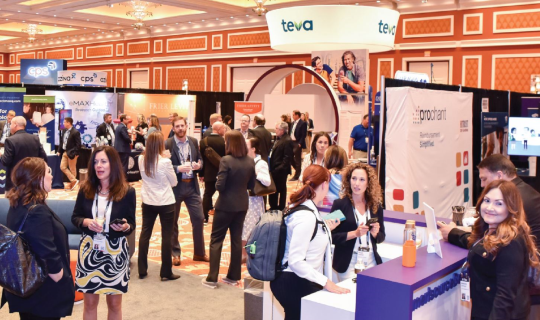Untangle the complexities of launching a biosimilar
By AmerisourceBergen

4-minute read
Expert tips for biopharma companies to go to market with confidence

For patients, the promise of biosimilars is clear: As safe and effective as the products they're intended to supplement or replace, they're also less expensive for manufacturers to produce. For those who are looking for much-needed medications at prices they can more easily afford, biosimilars are often seen as a simple way to lower personal healthcare costs.

On a much larger scale as well, biosimilars have had an impact on healthcare that economists and others find hard to ignore. Biologics, after all, only account for 2 percent of prescriptions in the United States, but analyses have shown they're responsible for close to 40 percent of net drug spending. In part because these medications tend to cost less than their competing reference products, between 2015 and 2021, biosimilar launches helped create an estimated $21 billion in healthcare savings. Looking ahead, as the biosimilar market grows, the cost reductions are expected to accelerate to $181 billion over the next five years.
For biopharma companies with biosimilars in the pipeline, none of this is surprising news. Along with data on the efficacy of their products, the cost savings they can deliver for providers and their patients is typically at the top of their marketing pitch. Still, when it comes to launching a biosimilar, those with experience know that success depends on more than dollars and cents. Instead, it's important to have a strategy that takes into account everything from the precise date of launch to patient and provider education. Here, we'll take a look at what experts consider industry best practices for bringing biosimilars to market.
According to Todd Reiter, Senior Director, Market Access Commercialization at Cencora, most biopharma companies with biosimilar products that have either been approved or are currently under FDA review would do well to tailor their launch strategy to the unique needs of their organization. A company that develops biosimilars and reference products, for example, should probably take a different approach than one that focuses exclusively on biosimilars.
“There's a dance that has to occur," Reiter explains, when a company with both reference biologics and biosimilars meets with payers to discuss their new product. “You don't want to disparage reference products when you're selling reference products yourself, but you also need to show payers why your biosimilar is an option to the reference product and something they should consider." For manufacturers of biosimilars only, such conversations are usually more straightforward. “In their case, they have more latitude because they have less to lose," Reiter says.
Once your launch is on the calendar, you can turn your attention to pricing. The most important factor to keep in mind here: where the market is likely to be at that specific point in time.
For biopharma companies with biosimilars in the pipeline, none of this is surprising news. Along with data on the efficacy of their products, the cost savings they can deliver for providers and their patients is typically at the top of their marketing pitch. Still, when it comes to launching a biosimilar, those with experience know that success depends on more than dollars and cents. Instead, it's important to have a strategy that takes into account everything from the precise date of launch to patient and provider education. Here, we'll take a look at what experts consider industry best practices for bringing biosimilars to market.
Different companies, different approaches
Since 2015, when Filgrastim-sndz was deemed by the FDA to be safe and fit for use in the United States, a total of 40 biosimilars have been approved for distribution by the agency. Of these, as of early 2023, 29 have gone on to launch.According to Todd Reiter, Senior Director, Market Access Commercialization at Cencora, most biopharma companies with biosimilar products that have either been approved or are currently under FDA review would do well to tailor their launch strategy to the unique needs of their organization. A company that develops biosimilars and reference products, for example, should probably take a different approach than one that focuses exclusively on biosimilars.
“There's a dance that has to occur," Reiter explains, when a company with both reference biologics and biosimilars meets with payers to discuss their new product. “You don't want to disparage reference products when you're selling reference products yourself, but you also need to show payers why your biosimilar is an option to the reference product and something they should consider." For manufacturers of biosimilars only, such conversations are usually more straightforward. “In their case, they have more latitude because they have less to lose," Reiter says.
Be prepared for launch
Biosimilar manufacturers should closely consider any patent and exclusivity protections that may apply to the reference product and understand that they may be met with legal challenges. The expertise of a partner who understands market intelligence and the nuances of patent expiration is key. Reiter recommends waiting for patent expiration and then bringing your product to market as close to that date as you can.Once your launch is on the calendar, you can turn your attention to pricing. The most important factor to keep in mind here: where the market is likely to be at that specific point in time.
"There are a lot of moving parts to deal with. It's not the kind of thing you want to do alone."
Todd Reiter
Setting the wholesale acquisition cost (WAC) is another opportunity for a partner to aid in the process. A market access partner can guide in the planning process that is required to understand how to best set the WAC. Since this number typically does not change, it is essential to have all the pertinent information to make the “best” decision from the start. The calculations are complicated and usually require substantial expert analysis, but because the stakes are high, the investment in time and effort can pay big dividends down the road. “If you get it right, you'll drive market share and uptake, but if you miss, you'll probably fail," he says.
Your pricing strategy will have a trickle-down effect on stakeholders. An appropriate price means payers will be more likely to add the biosimilar to their formularies. Providers will also consider price when choosing whether to prescribe your new biosimilar or the reference product or a competing biosimilar for their patients.
Purchasing and distribution
Beyond enticing payers and providers with strong pricing, it's imperative for any biosimilar manufacturer to have a strategy for convincing clinics to adopt their product. This work begins with deciding exactly which payers and clinics to target, but it also requires a clear understanding of how much product you'll be able to supply. And finally, Reiter says, it involves education—raising product awareness among physicians and patients so they know exactly what you have to offer and how your biosimilar can help them.In this journey from bench to bedside, channel can’t be forgotten. Distributors are ultimately how the products get to the patients who need them. They ensure the relevant sites of care have access to the product when needed. The providers need access to the biosimilar, when they order it—or they may choose a competitor’s product that is more readily available. The final piece of the puzzle—patient and provider education—is similarly difficult because the coverage and payment landscape for biopharmaceuticals is so complex, Reiter notes. Manufacturers usually tackle this aspect of the launch with the help of reimbursement specialists with knowledge about everything from local and regional payer issues to proper utilization of patient assistance programs.
“Biosimilar manufacturers basically have to do the same things that the reference product manufacturer does from a patient support perspective," he says. This may include developing educational initiatives designed to raise awareness about the benefits of your product and its role in improving patient access to important therapies.
In the end, Reiter recommends that biosimilar manufacturers work closely with industry experts and consultants to ensure their launch goes off without a hitch. “There are a lot of moving parts you have to deal with," he says. “It's not the kind of thing you want to do alone."





